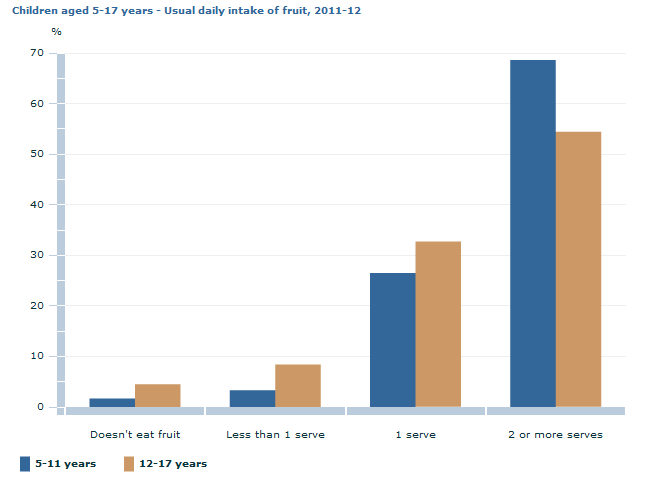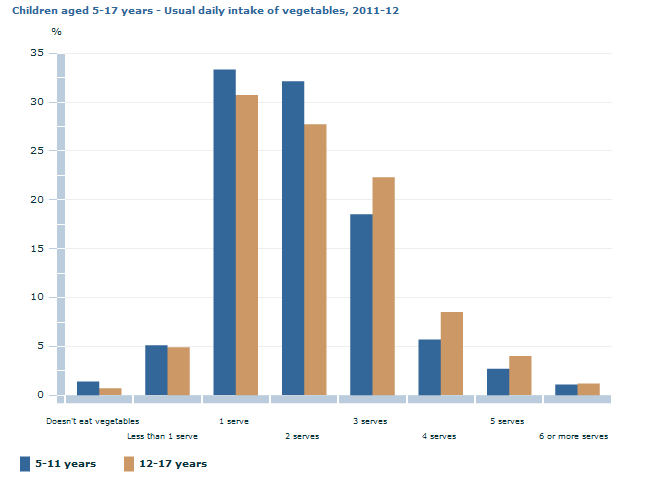4338.0 - Profiles of Health, Australia, 2011-13
ARCHIVED ISSUE Released at 11:30 AM (CANBERRA TIME) 07/06/2013 First Issue
Page tools:
 Print Page Print Page
 Print All Print All
| ||||
Healthy habits formed early in life can follow on throughout childhood, adolescence and into adulthood. Conversely, less than healthy habits established in childhood may continue into adulthood, increasing a person's associated health risks such as cardiovascular disease, high blood pressure and Type 2 diabetes. In 2011-12, 25.1% of children aged 2–17 years were overweight or obese, comprised of 18.2% overweight and 6.9% obese. Overweight and obesity rates differed only slightly across children's age groups, ranging from 22.8% for children aged 2 to 4 years, to 26.6% for children aged 12 to 15 years. The proportion of children aged 5-17 years who were overweight or obese increased between 1995 and 2007-08 (20.9% and 24.7%, respectively) and then remained stable to 2011-12 (25.7%). Proportionally, the number of boys aged 5–17 years who were overweight or obese was not significantly different from the number of girls (25.0% compared with 26.3%). , 2011-12.gif) Footnote(s): (a) Based on Body Mass Index for children whose height and weight was measured. Source(s): Australian Health Survey: Updated Results, 2011-12 Good nutrition can have many positive health benefits. In 2011-12, children aged 5-11 years generally ate more fruit than children aged 12-17. Almost seven out of ten (68.6%) children aged 5 to 11 ate two or more serves of fruit on a usual day, compared with 54.4% of 12 to 17 year olds. However children aged 12-17 years generally ate more vegetables than children aged 5-11 with 36.0% of children aged 12-17 consuming three or more serves of vegetables on a usual day compared with only 28.0% of children aged 5-11. The usual daily intake of fruit and vegetables followed a similar pattern between boys and girls.  Source(s): Australian Health Survey: Updated Results, 2011-12  Source(s): Australian Health Survey: Updated Results, 2011-12 Milk is an excellent source of vitamins and minerals, particularly calcium, which is important for forming strong and healthy bones. In 2011-12, almost all children (97.9%) aged 5-17 years consumed milk; the majority of children consumed cow's milk (95.7%), followed by soy milk (1.7%).
Previous results for children's risk factors National Health Survey 2007–08, 2004–05, 2001, 1995 National Aboriginal and Torres Strait Islander Health Survey, 2004-05 Other articles on children's risk factors The Health and Welfare of Australia's Aboriginal and Torres Strait Islander Peoples, 2010: Mothers' and children's health Australian Social Trends, Sep 2009: Children who are overweight or obese Health of Children in Australia: A Snapshot, 2004-05 Health of Children, 2004 Document Selection These documents will be presented in a new window.
|
||||
